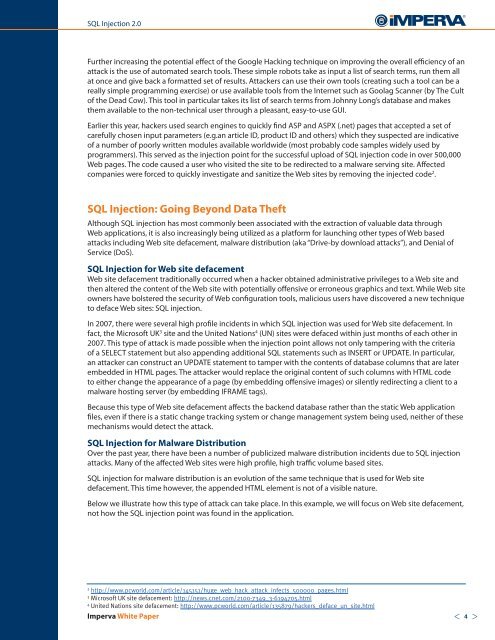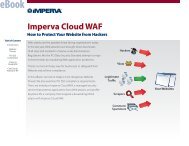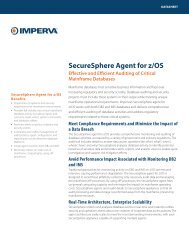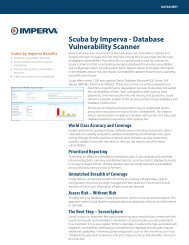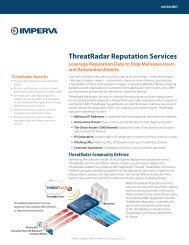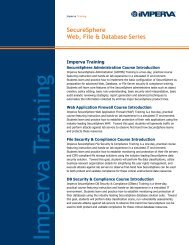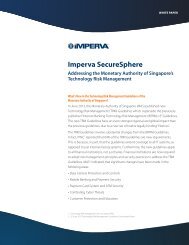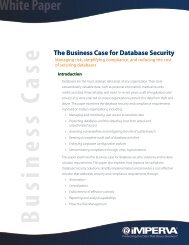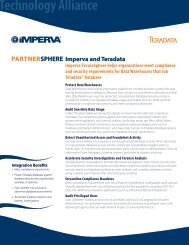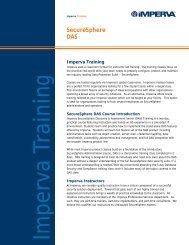SQL Injection 2.0 - Imperva
SQL Injection 2.0 - Imperva
SQL Injection 2.0 - Imperva
Create successful ePaper yourself
Turn your PDF publications into a flip-book with our unique Google optimized e-Paper software.
<strong>SQL</strong> <strong>Injection</strong> <strong>2.0</strong>Further increasing the potential effect of the Google Hacking technique on improving the overall efficiency of anattack is the use of automated search tools. These simple robots take as input a list of search terms, run them allat once and give back a formatted set of results. Attackers can use their own tools (creating such a tool can be areally simple programming exercise) or use available tools from the Internet such as Goolag Scanner (by The Cultof the Dead Cow). This tool in particular takes its list of search terms from Johnny Long’s database and makesthem available to the non-technical user through a pleasant, easy-to-use GUI.Earlier this year, hackers used search engines to quickly find ASP and ASPX (.net) pages that accepted a set ofcarefully chosen input parameters (e.g.an article ID, product ID and others) which they suspected are indicativeof a number of poorly written modules available worldwide (most probably code samples widely used byprogrammers). This served as the injection point for the successful upload of <strong>SQL</strong> injection code in over 500,000Web pages. The code caused a user who visited the site to be redirected to a malware serving site. Affectedcompanies were forced to quickly investigate and sanitize the Web sites by removing the injected code 2 .<strong>SQL</strong> <strong>Injection</strong>: Going Beyond Data TheftAlthough <strong>SQL</strong> injection has most commonly been associated with the extraction of valuable data throughWeb applications, it is also increasingly being utilized as a platform for launching other types of Web basedattacks including Web site defacement, malware distribution (aka “Drive-by download attacks”), and Denial ofService (DoS).<strong>SQL</strong> <strong>Injection</strong> for Web site defacementWeb site defacement traditionally occurred when a hacker obtained administrative privileges to a Web site andthen altered the content of the Web site with potentially offensive or erroneous graphics and text. While Web siteowners have bolstered the security of Web configuration tools, malicious users have discovered a new techniqueto deface Web sites: <strong>SQL</strong> injection.In 2007, there were several high profile incidents in which <strong>SQL</strong> injection was used for Web site defacement. Infact, the Microsoft UK 3 site and the United Nations 4 (UN) sites were defaced within just months of each other in2007. This type of attack is made possible when the injection point allows not only tampering with the criteriaof a SELECT statement but also appending additional <strong>SQL</strong> statements such as INSERT or UPDATE. In particular,an attacker can construct an UPDATE statement to tamper with the contents of database columns that are laterembedded in HTML pages. The attacker would replace the original content of such columns with HTML codeto either change the appearance of a page (by embedding offensive images) or silently redirecting a client to amalware hosting server (by embedding IFRAME tags).Because this type of Web site defacement affects the backend database rather than the static Web applicationfiles, even if there is a static change tracking system or change management system being used, neither of thesemechanisms would detect the attack.<strong>SQL</strong> <strong>Injection</strong> for Malware DistributionOver the past year, there have been a number of publicized malware distribution incidents due to <strong>SQL</strong> injectionattacks. Many of the affected Web sites were high profile, high traffic volume based sites.<strong>SQL</strong> injection for malware distribution is an evolution of the same technique that is used for Web sitedefacement. This time however, the appended HTML element is not of a visible nature.Below we illustrate how this type of attack can take place. In this example, we will focus on Web site defacement,not how the <strong>SQL</strong> injection point was found in the application.2http://www.pcworld.com/article/145151/huge_web_hack_attack_infects_500000_pages.html3Microsoft UK site defacement: http://news.cnet.com/2100-7349_3-6194705.html4United Nations site defacement: http://www.pcworld.com/article/135879/hackers_deface_un_site.html<strong>Imperva</strong> White Paper< 4 >


